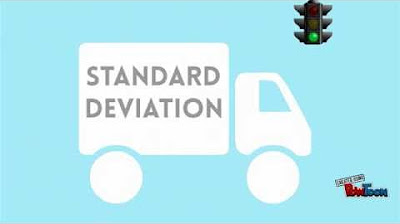Standard Deviation & Degrees of Freedom Explained | Statistics Tutorial | MarinStatsLectures
Summary
TLDRThis video script delves into the concept of standard deviation, aiming to clarify its purpose beyond the formula. It uses a simple dataset with four observations to illustrate how standard deviation measures the average deviation from the mean. The presenter discusses the idea of absolute deviations and why squaring them is preferred for calculations. The script also explains the variance and the rationale behind using 'n-1' in the sample standard deviation formula, emphasizing the loss of degrees of freedom when estimating the mean.
Takeaways
- 📊 Standard deviation is a measure of how spread out numbers in a dataset are, indicating the average distance of each number from the mean.
- 🤔 The video encourages viewers to conceptualize their own formula for measuring average deviation from the mean before introducing standard deviation.
- 🔢 The script presents a simple dataset with four observations and a mean of 80 to facilitate understanding of the concept without complex calculations.
- 🚫 The initial formula suggested by viewers averages absolute deviations, which has limitations due to cancellation of positive and negative values.
- 📉 To address the limitations of absolute values, the video introduces the concept of squaring deviations to eliminate negative values and ensure a meaningful interpretation.
- 🧮 Squaring deviations leads to the calculation of variance, which is the average of squared deviations from the mean, but has units squared (e.g., percentage squared), making it hard to interpret.
- 🔄 To resolve the issue of squared units, the square root of variance is taken, resulting in the standard deviation, which brings the units back to the original scale.
- 🔢 The standard deviation is mathematically defined as the square root of the average squared deviation, which can be thought of as the average deviation conceptually.
- ⚖️ The video explains the reason for dividing by (n-1) in the sample standard deviation calculation, which is related to the loss of one degree of freedom when estimating the mean from the data.
- 🔄 The concept of degrees of freedom is introduced to explain why (n-1) is used in the denominator, emphasizing that each estimation from the data reduces the degrees of freedom by one.
- 💡 The video provides a conceptual explanation for the use of (n-1) that is accessible to most viewers, suggesting that a mathematical explanation is available for those interested.
Q & A
What is the main focus of the video?
-The video focuses on explaining the concept of standard deviation and what it measures.
Why does the presenter suggest pausing the video?
-The presenter suggests pausing the video to allow viewers to think about and develop their own formula for capturing the average deviation of individual observations from the mean.
What is the sample mean of the dataset used in the example?
-The sample mean of the dataset used in the example is 80.
Why does the presenter suggest using absolute values in the initial thought process?
-The presenter suggests using absolute values to avoid negative and positive deviations canceling each other out when calculating the average deviation from the mean.
What is the formula for average absolute deviation?
-The formula for average absolute deviation is the sum of the absolute values of (Xi - Xbar) divided by n, where Xi represents individual observations and Xbar represents the mean.
Why is the average absolute deviation not commonly used in favor of standard deviation?
-The average absolute deviation is not commonly used because its plot is not smooth and functions involving absolute values are more difficult to work with mathematically.
What is the alternative to using absolute values to handle negative and positive deviations?
-The alternative is to square the deviations, which eliminates the issue of negative and positive values canceling each other out.
What is variance and how is it calculated?
-Variance is the average of the squared deviations from the mean. It is calculated as the sum of (Xi - Xbar)^2 divided by n for a sample.
Why do we take the square root of variance to get standard deviation?
-We take the square root of variance to get back to the original units of measurement and to make the value more interpretable.
What is the reason for using n-1 in the denominator instead of n when calculating sample standard deviation?
-The reason for using n-1 in the denominator is to account for the loss of one degree of freedom when using the data to estimate the sample mean.
Can you explain the concept of degrees of freedom in the context of standard deviation?
-Degrees of freedom refer to the number of values in the final calculation that are free to vary. When estimating the mean, one degree of freedom is lost, so we use n-1 to adjust for this in the calculation of the sample standard deviation.
Outlines

This section is available to paid users only. Please upgrade to access this part.
Upgrade NowMindmap

This section is available to paid users only. Please upgrade to access this part.
Upgrade NowKeywords

This section is available to paid users only. Please upgrade to access this part.
Upgrade NowHighlights

This section is available to paid users only. Please upgrade to access this part.
Upgrade NowTranscripts

This section is available to paid users only. Please upgrade to access this part.
Upgrade Now5.0 / 5 (0 votes)





